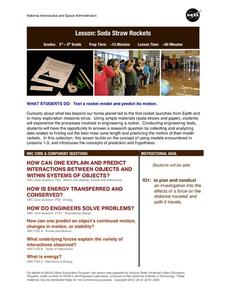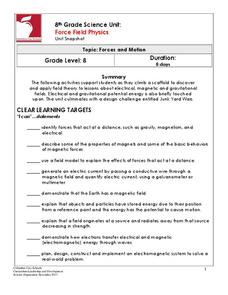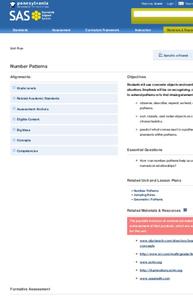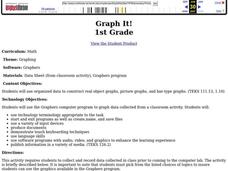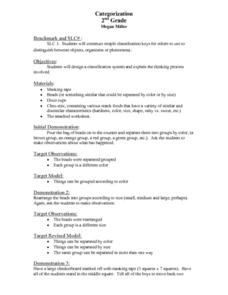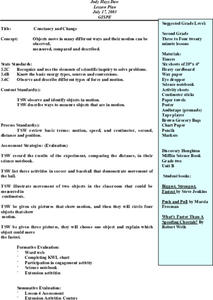Curated OER
Splash & Splatter
Students research the work of Jackson Pollock, a 20th century painter. They experiment with splatter-painting methods and discover the meaning of field or action painting, terms used to describe Pollock's abstract work. Students apply...
Curated OER
Space Words and Comparatives
Which is bigger: the sun or the moon? Which is nearer: the planets or a star? English Language Learners first located a series of space-related nouns and adjectives in a word search, and then identify the comparative and superlative...
Denver Art Museum
Words-A-Buzz
Here's an art instructional activity for pre-schoolers which focuses on communicating through words and movement. Learners explore the traditions of the samurai grip enhancers and characteristics of wasps. Photographs, embedded in the...
NASA
Soda Straw Rockets
Three, two, one, blast off to a better understanding of force and motion with this exciting science lesson! Beginning with a discussion about rockets and gravity, young scientists go on to complete a series of worksheets about net...
Columbus City Schools
Force Field Physics
Attracted class members to an activity-packed journey through the science behind the invisible forces at work all around us. From jump rope generators to junkyard wars, there's never a dull moment when eighth grade physics scholars...
Mary Pope Osborne, Classroom Adventures Program
Mummies in the Morning Egyptian pyramids, hieroglyphics
Visit the Magic Treehouse and take your class on a trip through time with a reading of the children's book Mummies in the Morning. Using the story to spark an investigation into Egyptian culture, this literature unit engages...
Texas Instruments
TI-Nspire™ CAS
When it comes to rating educational calculators, this calculator is always near the top of this list. Now it's available as an app. There is a lot of calculator power wrapped up in this app. Not only is this a fully functioning...
Texas Instruments
TI-Nspire™
We landed on the moon with less computing capabilities than you can find in this app! Here is a multiple function calculator that takes all the power you get from a handheld and adds the wonderful large screen that only a tablet can...
Curated OER
Avalanche!
Students explain that when forces on an object are balanced, the motion of object does not change. They describe how an object changes its motion when forces on it are unbalanced. They plan and conduct a scientific investigation to test...
Curated OER
Using Parallax to Determine Distances
Pupils examine the concept of parallax. They determine a method to calculate the distance of objects from their data, participate in a demonstration, and describe how our eyes use parallax to determine the distance of objects.
Curated OER
The Senses
Students explore activities involving the five senses. They describe objects by touch and participate in craft corners using sand, rice, and blocks. They taste various foods and use their sight to find missing objects. They practice...
Curated OER
Number Patterns
First graders use manipulatives to complete and extend patterns. In this patterns lesson plan, 1st graders complete a pattern with a missing element, extend a pattern, and sort objects by characteristics.
Curated OER
Houses
Third graders use a number of problem solving strategies in this unit of lessons. They determine how to draw and model three-dimensional objects, use co-ordinate systems, determine probability of events, and identify paths of simple...
Curated OER
Graph It!
First graders use organized data to construct real object graphs, picture graphs, and bar-type graphs.
Curated OER
Categorization
Second graders participate in a teacher led bead sorting activity in which they describe different ways the beads can be grouped. Next, they participate in activities in which they sort and resort themselves into groups according to...
Curated OER
Language Arts: Using Descriptive Adjectives
First graders listen to "Behind the Mask" and identify all the descriptive adjectives in the story. After discussing the importance of using adjectives, they brainstorm lists of adjectives to describe jack o lanterns. Finally, 1st...
Curated OER
Six Blind Men And The Elephant
Students practice story related vocabulary. They create a list of adjectives to describe objects. They predict the outcome of the story while listening to it. They memorize an elephant rhyme.
Alabama Learning Exchange
Introduction to the Universe
Fifth graders write descriptive imagery and identify facts about various components of the universe. They listen to the book "The Magic School Bus, Lost in the Solar System," develop a list of descriptive words from the story, compose a...
Curated OER
Science- Unit on Matter- Solids
Second graders identify and describe properties of matter.
They identify three forms of matter- solids, liquids, and gases with 100% accuracy. The student describes the properties of solid objects.
Curated OER
Comparing Data
Eighth graders create a survey, gather data and describe the data using measures of central tendency (mean, median and mode) and spread (range, quartiles, and interquartile range). Students use these measures to interpret, compare and...
Curated OER
Constancy and Change
Second graders investigate how objects can move in different ways. They move in different ways across the room and develop a class list of movement words. Students also conduct a measuring motion experiment, create a bar graph for the...
Curated OER
Our World of shapes
First graders listen to Shapes and The Greedy Triangle to identify and describe examples of geometric shapes. For this geometric shapes lesson, look for geometric shapes in real world places. Students make a mobile of shapes...
Curated OER
Science: Solids
Second graders investigate the properties of solids and discover how to classify them. Using rulers, they measure various solids on display. In groups, they play an identification game where one students names a location, such as the...
Curated OER
Space Science
Eighth graders study the objects in our solar system. In this space instructional activity students identify and describe planets, then classify them as terrestrial or gaseous.



